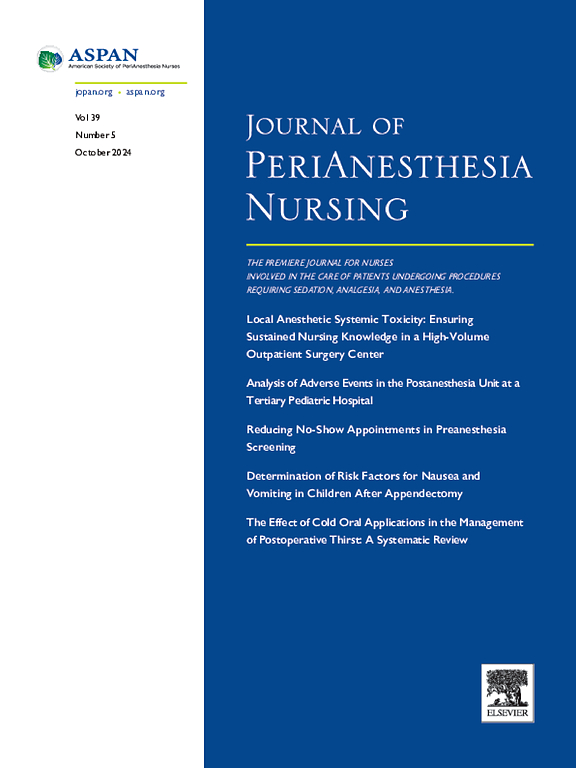优化儿童扁桃体切除术后的恢复:无阿片类药物麻醉和镇痛的应用。
IF 2
4区 医学
Q2 NURSING
引用次数: 0
摘要
目的:阿片类药物被认为是控制术后急性疼痛的金标准。然而,副作用,如恶心、呕吐、呼吸抑制和疼痛敏感引起了极大的关注。扁桃体肿大和睡眠呼吸暂停的儿童的风险更高,因此有效的疼痛管理同时最大限度地减少与镇痛相关的副作用是一个紧迫的问题。设计:这是一项随机(1:1)、单盲、平行组优势试验。方法:对44例3 ~ 7岁儿童进行前瞻性单盲研究,这些儿童计划在全身麻醉下行扁桃体切除术。采用计算机辅助随机化方法将患者随机分为实验组和对照组两组。对照组采用标准化阿片类药物进行全麻诱导和维持。实验组用艾氯胺酮、右美托咪定等非阿片类药物替代用于麻醉诱导和维持的阿片类药物。主要结局是术后48小时内的疼痛评分,次要结局包括首次进食的时间、睡眠质量、恶心、呕吐、呼吸抑制、镇痛不足、需要氢吗啡酮抢救镇痛的儿童人数、心理症状的差异,如兴奋和幻觉、术后出血和护理人员满意度。结果:实验组术后48 h疼痛评分明显低于对照组,6、12、24 h P < 0.01, 48 h P < 0.05,差异均有统计学意义。在不良事件发生率方面,实验组患儿睡眠质量较对照组好,恶心呕吐较少,需氢吗啡酮救急镇痛次数较少。结论:非阿片类麻醉镇痛方案可改善儿童扁桃体切除术后48 h内疼痛评分,改善睡眠质量,缩短首次进食时间,减少镇痛不足和恶心呕吐发生率,提高护理人员满意度。本文章由计算机程序翻译,如有差异,请以英文原文为准。
Optimizing the Recovery of Pediatric Tonsillectomy: Application of Opioid-Free Anesthesia and Analgesia
Purpose
Opioids are considered the gold standard for controlling postoperative acute pain. However, side effects such as nausea, vomiting, respiratory depression, and pain sensitization have gained significant attention. The risks are higher in children with enlarged tonsils and sleep apnea, making effective pain management while minimizing analgesia-related side effects a pressing concern.
Design
This was a randomized (1:1), single-blind, parallel-group superiority trial.
Methods
A prospective single-blind study was conducted with 44 children aged 3 to 7 years who planned to undergo tonsillectomy under general anesthesia. They were randomized into two groups: the experimental group and the control group using computer-assisted randomization. The control group received standardized opioid drugs for general anesthesia induction and maintenance. In the experimental group, the opioid drugs used for anesthesia induction and maintenance were replaced with nonopioid alternatives such as esketamine and dexmedetomidine. The primary outcome of interest was the pain score within 48 hours after surgery, while the secondary outcomes included the time to first food ingestion, sleep quality, nausea, vomiting, respiratory depression, insufficient analgesia, number of children requiring hydromorphone rescue analgesia, and differences in psychological symptoms such as excitement and hallucinations, postoperative bleeding, and caregiver satisfaction.
Findings
The experimental group experienced significantly lower pain scores within 48 hours post surgery compared with the control group, with statistical significance at P less than .01 for 6, 12, and 24 hours, and at P less than .05 for 48 hours post surgery. In terms of the incidence of adverse events, children in the experimental group reported better sleep quality, less nausea and vomiting, and needed fewer instances of hydromorphone rescue analgesia than those in the control group. Additionally, the experimental group had higher caregiver satisfaction (P < .05).
Conclusions
Nonopioid anesthesia and analgesia regimens can improve pain scores within 48 hours after tonsillectomy in children, improve sleep quality, shorten the time to first food ingestion, reduce the incidence of insufficient analgesia and nausea and vomiting, and increase caregiver satisfaction.
求助全文
通过发布文献求助,成功后即可免费获取论文全文。
去求助
来源期刊

Journal of Perianesthesia Nursing
NURSING-
CiteScore
2.20
自引率
17.60%
发文量
279
审稿时长
90 days
期刊介绍:
The Journal of PeriAnesthesia Nursing provides original, peer-reviewed research for a primary audience that includes nurses in perianesthesia settings, including ambulatory surgery, preadmission testing, postanesthesia care (Phases I and II), extended observation, and pain management. The Journal provides a forum for sharing professional knowledge and experience relating to management, ethics, legislation, research, and other aspects of perianesthesia nursing.
 求助内容:
求助内容: 应助结果提醒方式:
应助结果提醒方式:


